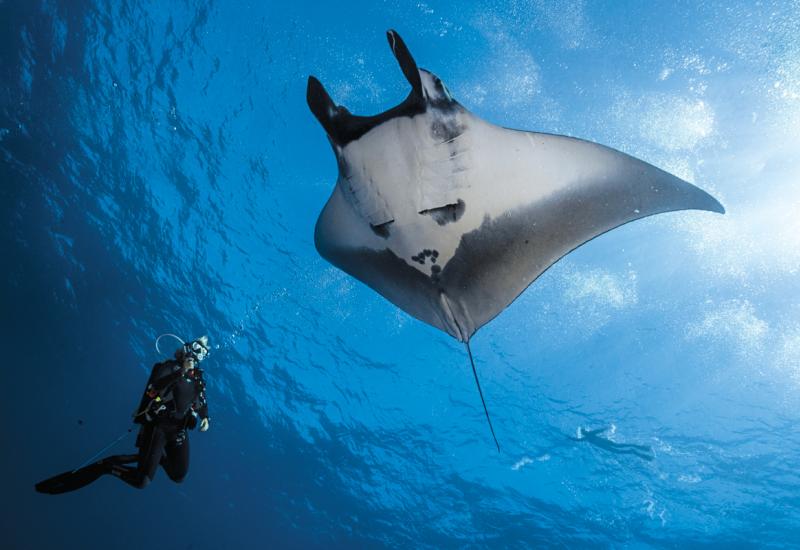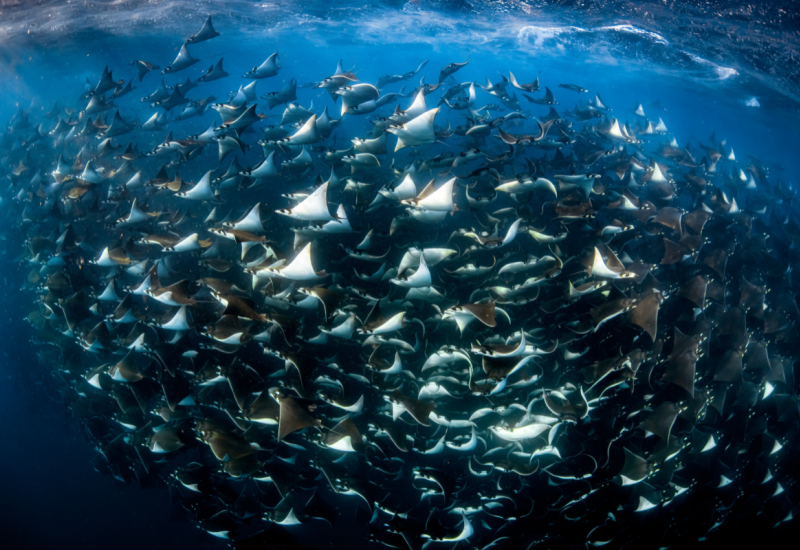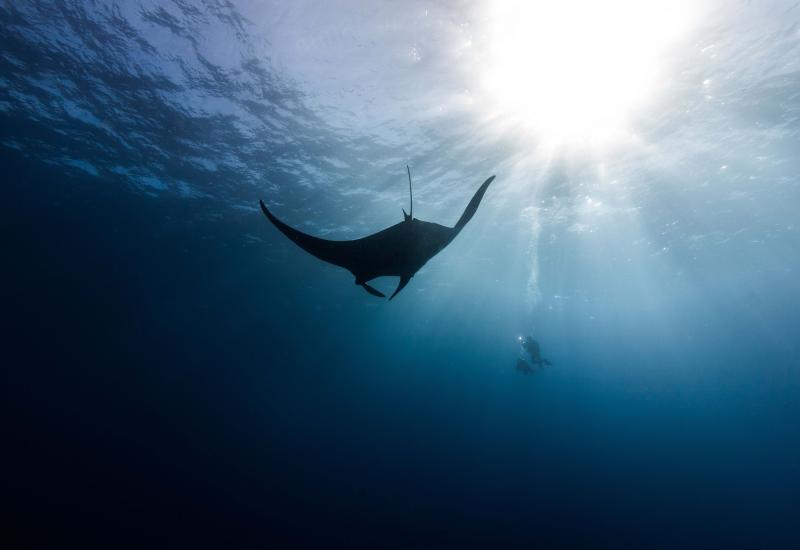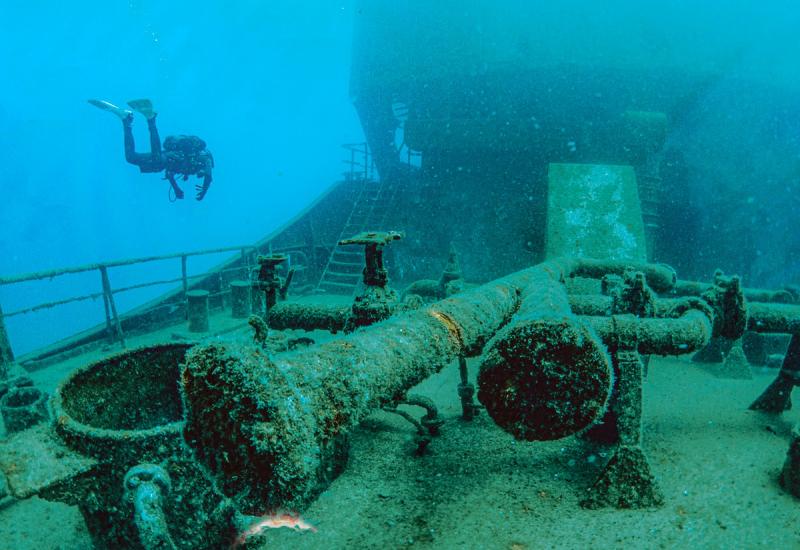Snorkeling with Baja’s Mobula Rays
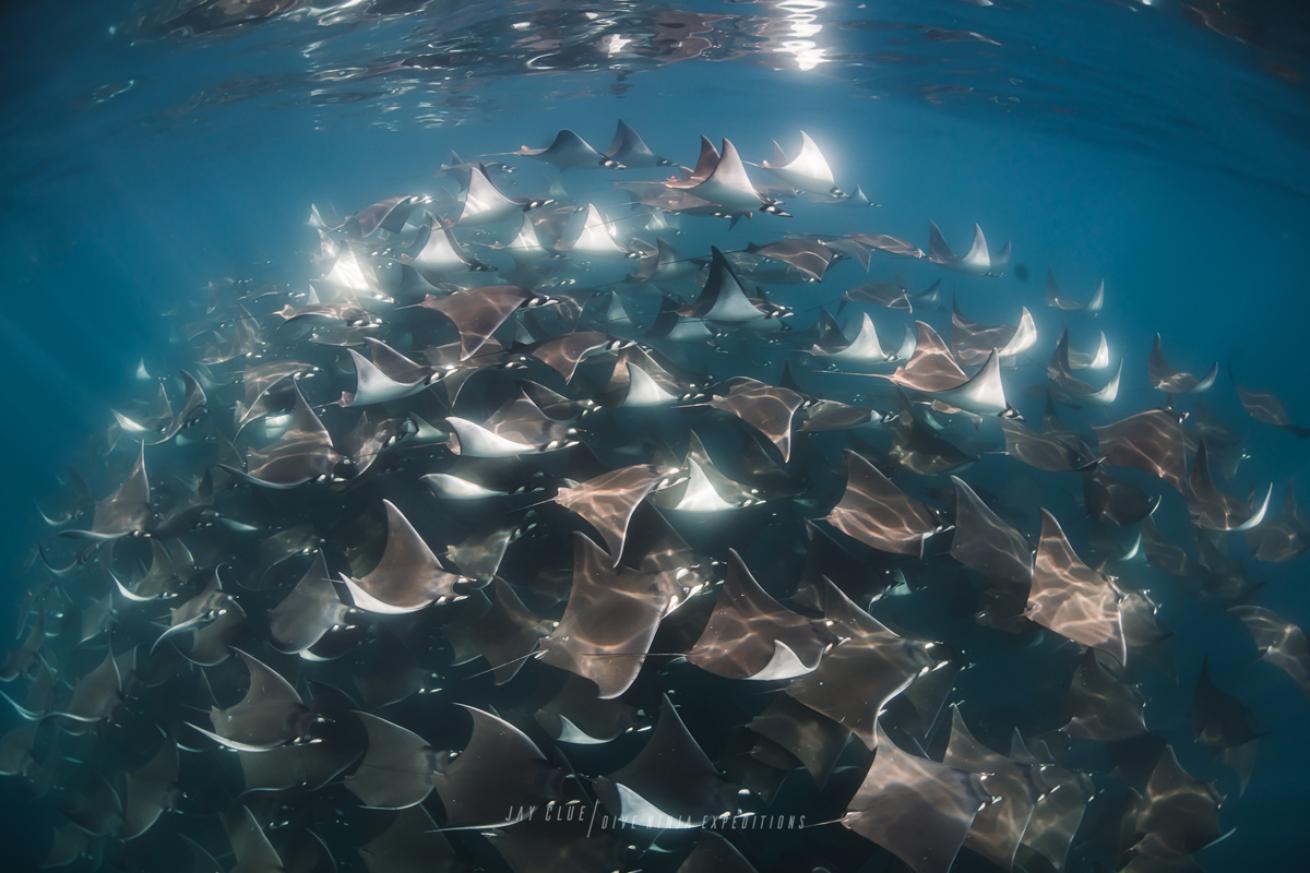
Jay ClueA fever of rays on a Dive Ninja Expedition.
There are few places in the world as magical as the Sea of Cortez (a.k.a the Gulf of California). Although this sliver of sea may not look formidable on a map, those fortunate enough to have visited know the secrets of its waters and the big animal encounters it can deliver. There’s a reason Jacques Cousteau famously gave it the moniker, “The World’s Aquarium.”
Until very recently, I have to admit the Sea of Cortez wasn’t on my list. It seemed like it would be too cold, too murky and too boring for a coral reef and macro lover like myself. I was wrong. As luck would have it, I found myself in Baja California Sur for two months in early 2021, attempting to find a safe haven as a digital nomad during the pandemic.
From season to season, the Sea of Cortez plays host to a plethora of pelagic marine life. 33 species of cetaceans, California sea lions, marlins, giant oceanic manta rays, whale sharks, hammerheads, mako sharks and numerous other noteworthy species can be spotted on any given trip into the sea. This is one of those places where you will be looking for one in-season species and spot several other bucket list animals. You never really know what’s going to turn up, and that’s the beauty of it.
The Mobula Rays of the Sea of Cortez
Recently, one Sea of Cortez phenomenon, in particular, has attracted a lot of attention across social media. That is the incredible mobula aggregations that occur every spring (from late April to July) and autumn/winter (from November to January) around Baja. Pro photographers from around the world have traveled to the area in the past few years to capture these incredible fevers. While these aggregations have never been a secret to locals, the publication of amazing photos showing thousands of rays gliding seamlessly through the water column has certainly caught the attention of the dive community around the world.
Before we go further, let’s clear one thing up. Most people are familiar with stingrays and manta rays, but what exactly are mobula rays? Mobula rays are elasmobranchs belonging to the genus Mobula. There are 10 species of mobula rays, including the eight species commonly known as devil rays and the two species commonly referred to as manta rays, namely giant oceanic manta rays and reef manta rays. Yes, all manta rays are mobula rays, but not all mobula rays are manta rays.
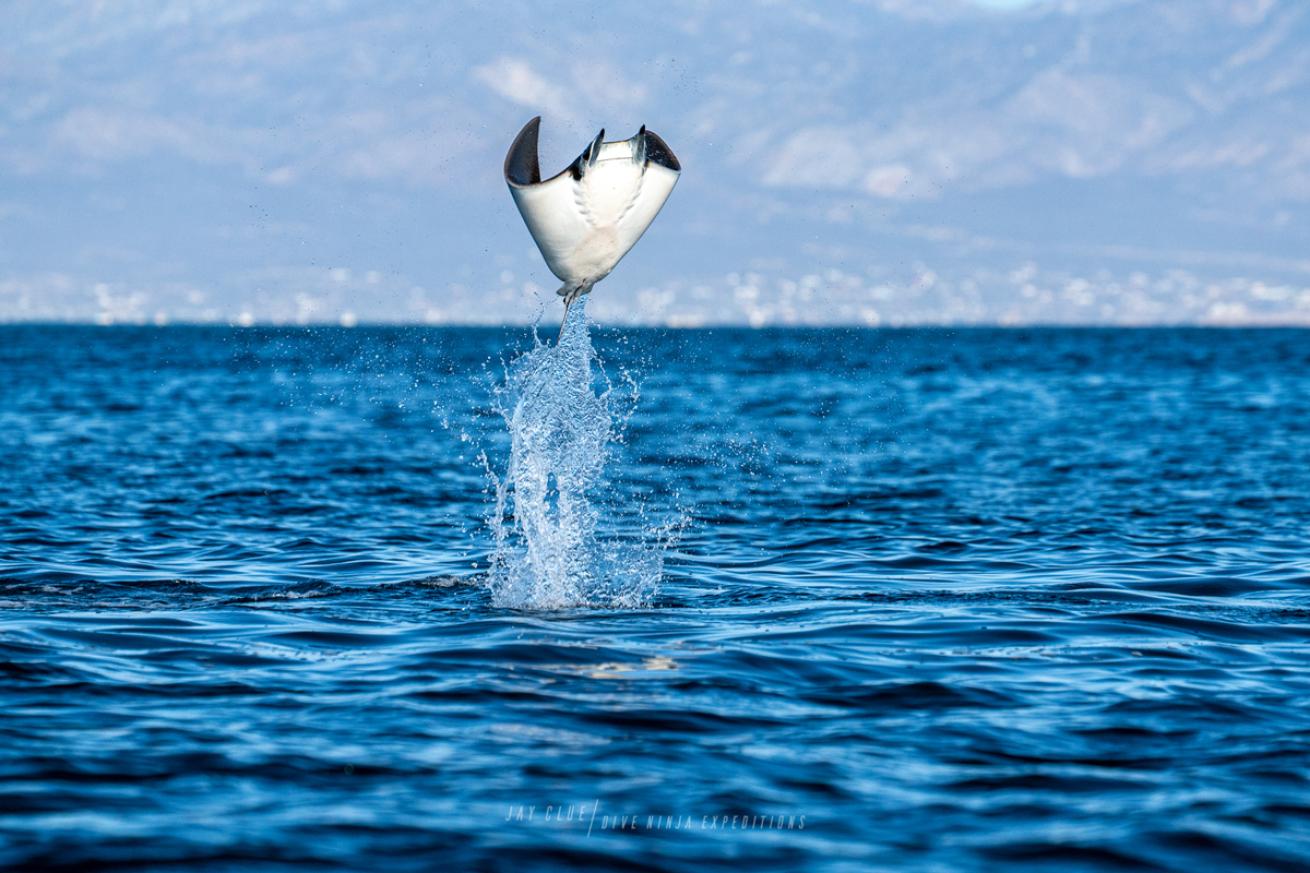
Jay ClueA mobula ray leaps out of the water.
Found in tropical and subtropical waters around the world, mobula rays are filter feeders that eat krill. Five of the 10 species are found in the Gulf of California and the eastern tropical Pacific, and the mobula rays most commonly spotted in huge aggregations near Baja California are Mobula Munkiana, or Munk’s Devil Rays.
Yet even as the popularity of mobula rays, and in particular devil rays, grows, populations are on the decline both in the Sea of Cortez and worldwide. These rays live long lives, grow slowly and reproduce infrequently. Munk’s Pygmy Devil Rays (or Pygmy Devilray) tend to live near the coast and, of course, exhibit large surface schooling behaviors. This makes them particularly vulnerable to both bycatch and environmental changes. As Melissa Cronin, PhD candidate and one of the project leaders for Mobula Conservation, states, “Mobulas are super threatened. They have the lowest growth rate of sharks and rays. They are circumglobal, and they are caught in crazy high numbers, about 13,000 a year in large school fisheries. In the last 10 or so years, people have started getting into mantas; however, mobulas make up a larger number of species, but they are understudied.”
The Intersection of Citizen Science and Mobula Rays
Melissa Cronin and Mobula Conservation’s two other female project leaders, Marta D. Palacios, PhD candidate, and Nerea Lezama-Ochoa, a postdoctoral researcher at the Environmental Research Division (NOAA, Monterey, USA) specializing in large pelagic species, are working hard to ensure mobula rays are no longer underrepresented. Their innovative projects are creating research for conservation, developing effective solutions that work for both the local communities and the future of mobula rays, and connecting science and people.
So far, their projects have led to fascinating and important developments, like identifying the first nursery area for a pygmy mobula ray in Baja California and collecting one of the world’s largest repositories of mobula ray tissue in the world. However, there’s still a lot of work to be done. To further their research and enlist a few helping hands, Marta D. Palacios has teamed up with Jay Clue and his company Dive Ninja Expeditions to develop citizen science retreats in a remote location near Cabo San Lucas.
Jay Clue is one of the aforementioned underwater photographers who initially became interested in Munk’s Devil Rays for their schooling behaviors, which led to outstanding underwater photography opportunities. He soon realized that the decimation of the population of mobula rays put them in a precarious position and that more research and more protection was needed for these fascinating creatures.
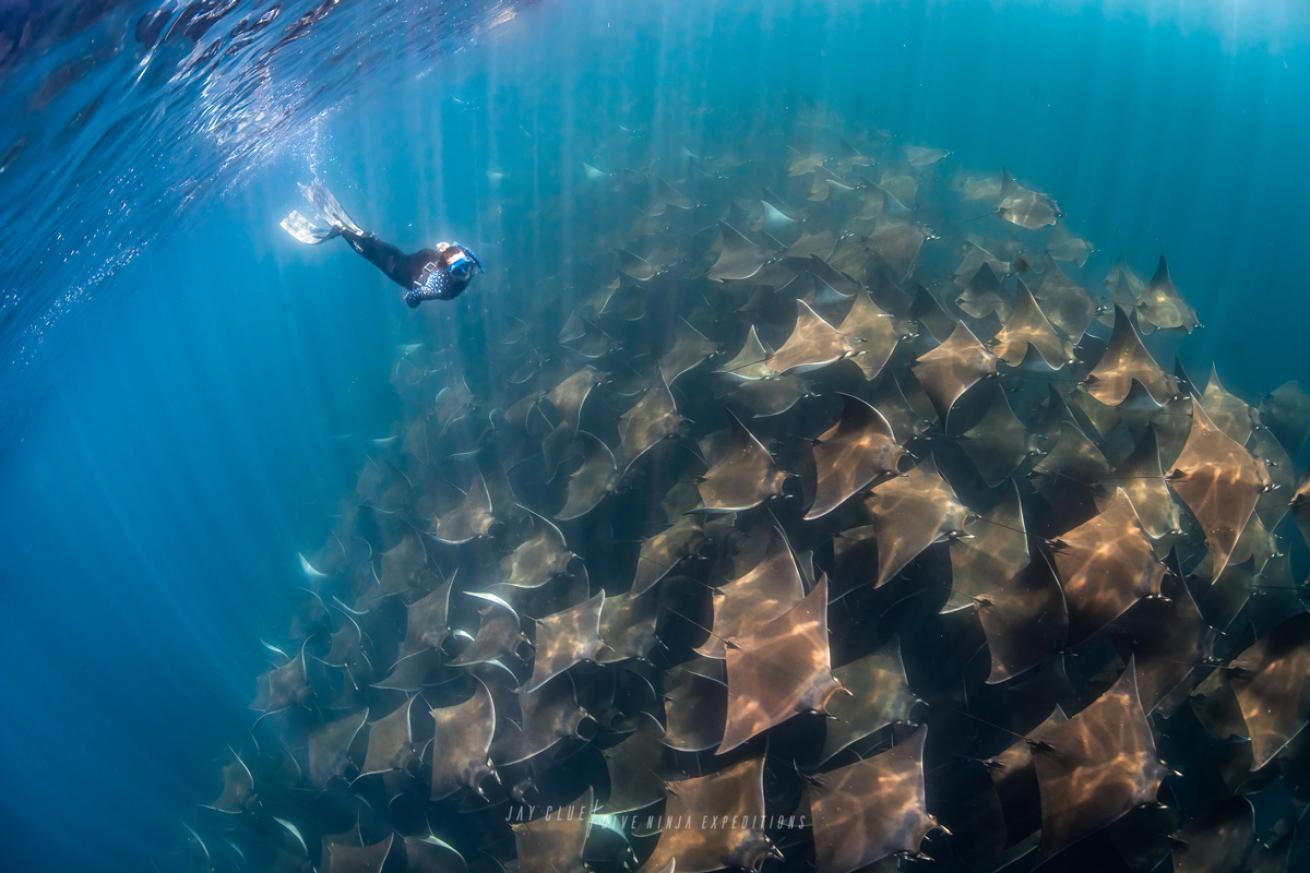
Jay ClueA freediver approaches a school of mobula rays during a Dive Ninjas expedition.
By creating citizen science expeditions, Jay and Dive Ninja Expeditions help average people share the water with these remarkable fish and contribute to a growing body of research to better understand and help protect them. In addition, a portion of every ticket sold for their citizen science trips helps fund Marta’s research on mobula rays.
Donna Schechter, one of the Dive Ninja Expeditions trip leaders, explains, “I think the mobula expedition is an opportunity to show some of the amazing things in Baja and the special shows the mobula rays put on. Beyond sharing this passion, the guests learn a lot about the species, about how vulnerable the rays are and what the guests can do to help protect them. Joining the citizen science activities, like taking pictures of the rays, also helps, and of course, donations to the research are great, too. Most of all, just allowing people to come here and experience the aggregation means they go home and tell their family and friends about the experience. One of the biggest things people can do to help is to spread knowledge. These animals are worth saving and worth protecting. People come here and have an experience they have never had before. Then, they go home and reach people who have never even thought such a thing exists.”
What It’s Like to Go on a Mobula Ray Citizen Science Expedition with Dive Ninja Expeditions
I was lucky enough to join one of Dive Ninja Expeditions’ Mobula Ray Citizen Science Expeditions, which run every year in May and June. The trips are either five days or eight days in length and leave from Cabo San Lucas. And, while you might be thinking that the term “expedition” lends itself to some sort of backcountry camping adventure, that couldn’t be further from the truth.
The trip began as we were picked up from Cabo San Lucas and whisked away with our fellow expedition members. Each trip is limited to just six participants as well as the trip leader. On our trip, we were joined by Donna Schecter, PADI Instructor for Dive Ninja Expeditions.
Upon arrival, we were greeted by the science superstar herself, Marta D. Palacios, at an amazing beachfront complex, where we would be based for the next several days. The expedition’s private chef, Reuben, was also there to make us our first four-course meal, stuffed clams, lentil soup, New York strip steak on a bed of local vegetables and homemade brownies à la mode. Reuben would quickly become everyone’s favorite person thanks to his delectable concoctions and gregarious personality.
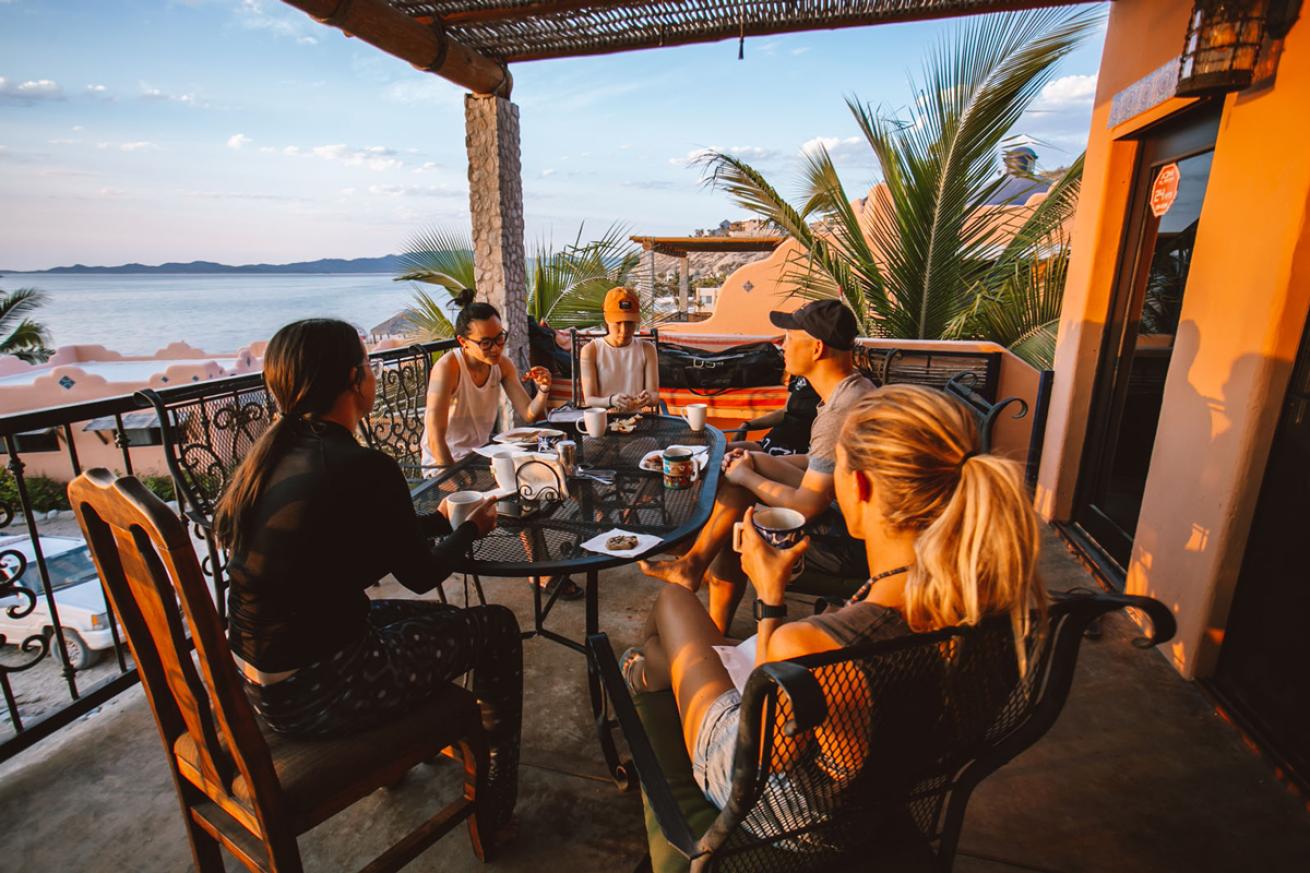
Alexa FernandoThe author and expedition group enjoy breakfast as the sun rises before a full day of scouting for rays.
Each day of the trip followed a similar routine. We would wake up with the sun each morning, have a light breakfast and meet Armando, our boat captain, on the beach. As early as possible, we were skimming along the flat surface of the Sea of Cortez in search of mobula rays. If conditions were good, we would stay on the water until early afternoon. If they weren’t, we’d head back in the late morning and try again in the late afternoon until the early evening.
On day one, the six of us eagerly jumped into the boat, followed by Donna and Marta, who are used to the giddy excitement of the expedition participants. With luck, it wasn’t more than five minutes before we spotted our first jumping mobula ray. Most believe the rays jump to attract a mate. Whatever the case, a jumping mobula ray is usually the first sign of their presence. And, our boat captain slows down to let us admire and photograph the acrobatics. Although our focus is taken up by the flapping and belly-flopping of the mobulas, Armando the captain is forever on the lookout for other interesting marine life. It’s not long before we hear him shout, “Whale!”
We motor about a hundred yards further and are greeted by a plume of water in the distance. This is one of the Bryde’s whales that are resident to the Sea of Cortez. It’s also one of the several other whales we would spot that day, including a group of humpbacks gleefully dancing and jumping further out at sea.
Yet, whales aren’t our target species. So before long, we drift onwards toward our goal, a group of a thousand or more mobula rays. Today, Poseidon smiles on us, and we find a massive aggregation of mobula rays, including pregnant females and juveniles, in calm water with excellent visibility.
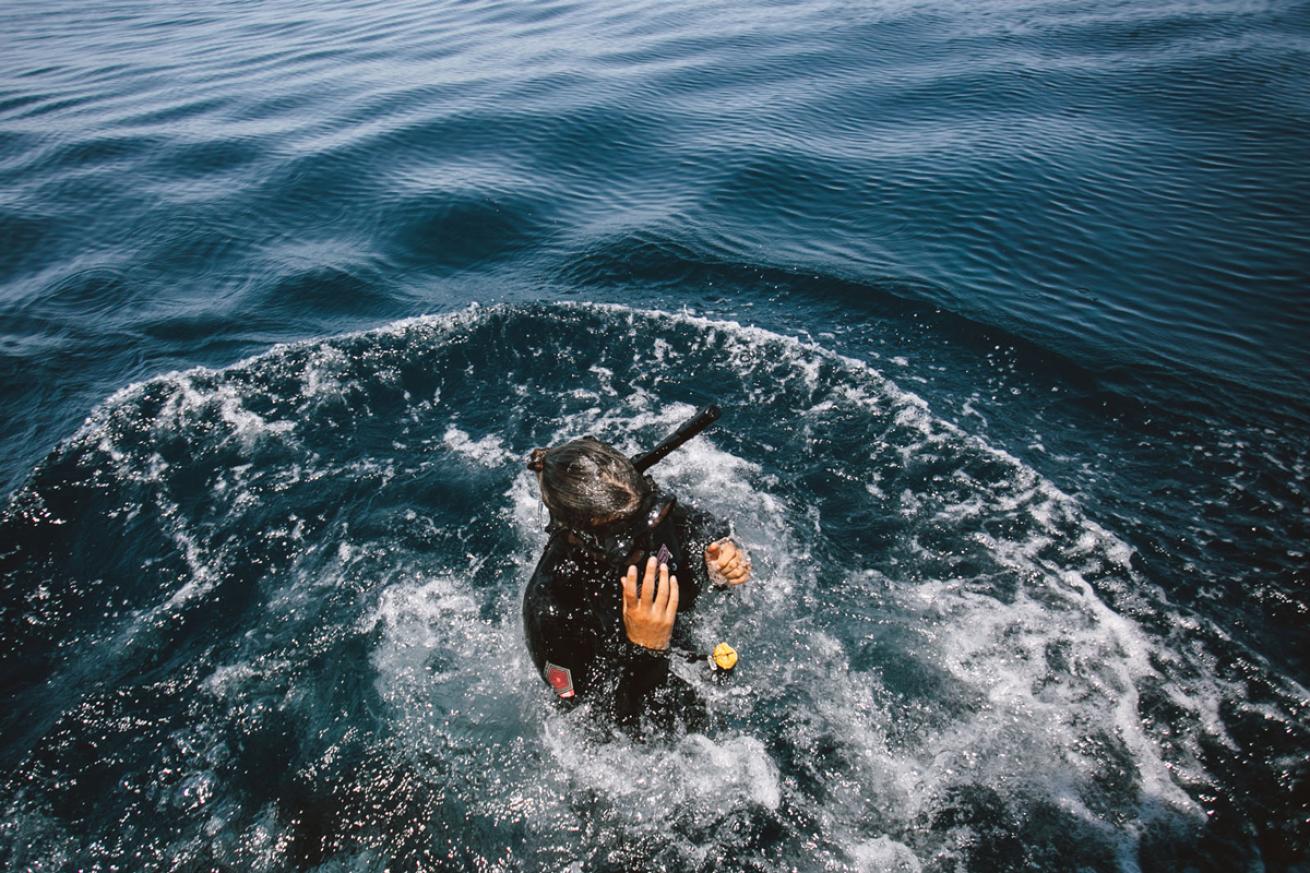
Alexa FernandoA snorkeler carefully enters the water by avoiding a big splash that could scare away the mobula rays.
It’s important to note that swimming with mobula rays is a delicate venture and following the code of conduct is actually beneficial to the animals and your chance of enjoying a prolonged interaction. One must enter the water without a splash, fin underwater without splashing on the surface and generally approach calmly. Otherwise, the rays could easily dive out of view. Marta also recommends that snorkelers forgo freediving until everyone in the group has had their fill. Freediving could also spook the rays, ruining the interaction for everyone.
Also, I should mention that this expedition is for snorkeling only. The bubbles from scuba divers scare off mobula ray aggregations, thought to be related to a bubble-blowing behavior used by orcas when hunting the rays.
Following this briefing, we were quickly in the water, and although the rays were moving swiftly, they allowed us to swim with them in the blue water for several hours. There’s no other way to describe what happened than magical.
Although we were all caught up in watching and photographing the humongous fever of rays, soon we were ready to help Marta with her research. During our initial entry, she dived in with a pair of cameras designed to help her take measurements of the rays. During the second jump, she asked us to help her collect fecal samples. Currently, she is collecting data to prove that the rays are actually feeding when they are in their aggregations. To prove that they are eating, she needs samples of their poop. Sure, this isn’t the most glamorous job in the world, but we all eagerly pitched in — in the name of science.
With a few fecal samples collected and hundreds of photographs taken, we happily headed back to our accommodations after a successful day out on the water.
Days two and three were slightly less successful than the first, but we still managed to snorkel on a couple beautiful reefs, see several more fevers of mobula rays and observe many more whales.
In addition to our time spent in and around the water, Marta gave presentations each day to educate us about mobula rays, the threats to their population, her research and what we can do to help.
Even though all the participants on the trip came from different backgrounds, some were PADI Divemasters while others had never been snorkeling before, but we all left with an appreciation for the beauty and fragility of mobula rays.
This is the type of trip that leaves you inspired for the future and with a willingness to get involved in mobula conservation. Although the mobula expeditions are only available for two months of the year, Dive Ninja also operates several other citizen science expeditions around a range of marine life, including marlin, whales and more. Any one of these citizen science expeditions will allow you to contribute to a growing body of research on the marine life of Baja California and get up close and personal with some of the most photographic species in the world.
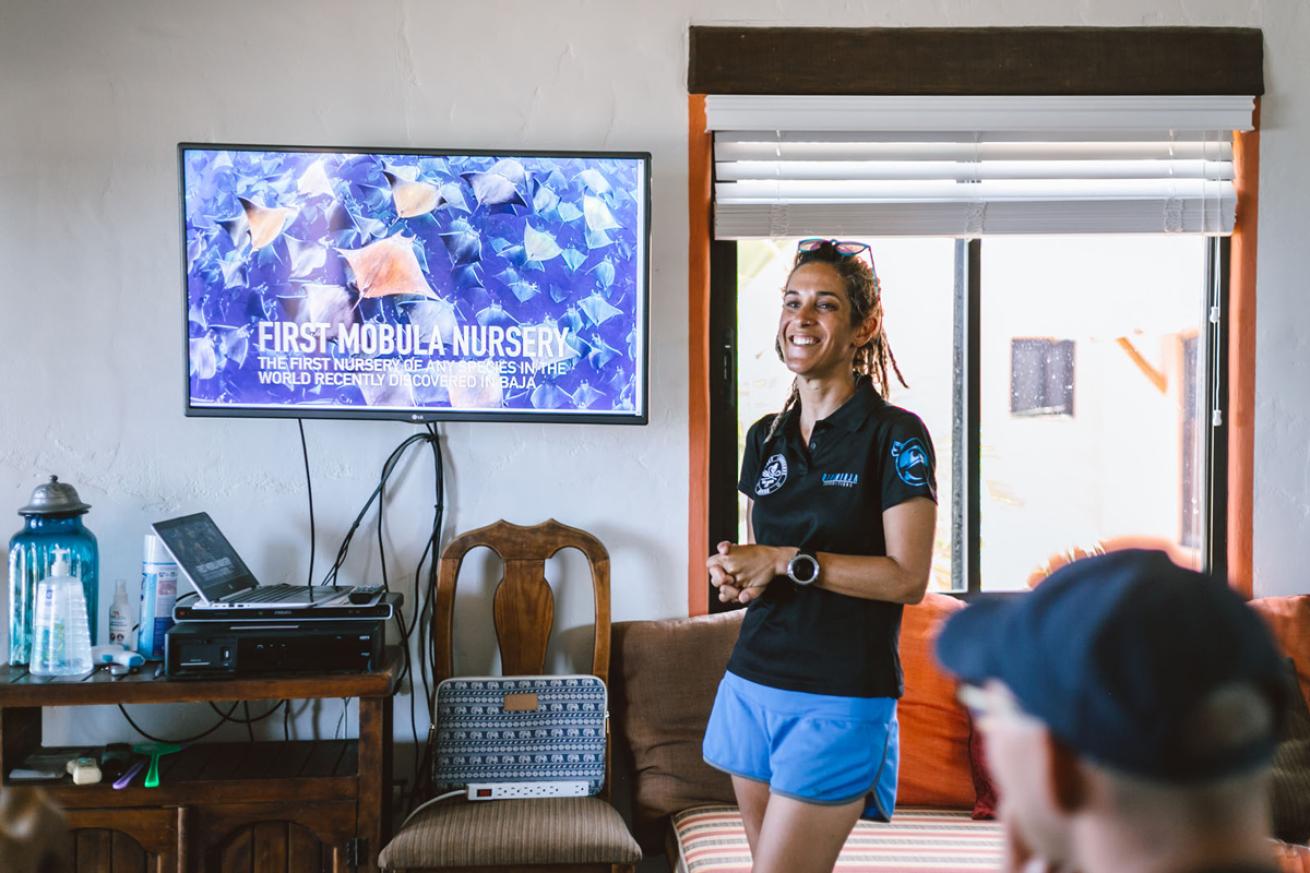
Alexa FernandoAn expedition leader gives a briefing ahead of the day's dives and search for mobula rays.
Need to Know
Operator: Dive Ninja Expeditions
Conservation Project: Mobula Conservation
Experience Level: Comfortable snorkeling in open water; No scuba certification needed.
Depth: 0-10m (0-30ft), if freediving
Conditions: In May and June, the water temperatures are variable, from 70 to 80 degrees Fahrenheit. Topside temperatures are consistently in the 90s.
Equipment: A 3mm wetsuit or dive skin is recommended for jellyfish protection. You’ll also need fins, a mask and a snorkel. If you’re freediving certified, you may also choose to wear a weight belt.
Many thanks to Jay Clue and Dive Ninja Expeditions for hosting me on the Mobula Ray Citizen Science Expedition. Thank you also to Marta, Donna, Reuben and Armando for their incredible hard work during the trip, and thanks to Alexa, Tianyu, Nadja, Michelle and Sushi for your enthusiasm and companionship.

